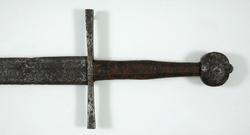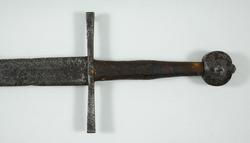Current Location: Gallery 31 (Armoury)
Maker(s)
Production:
Unknown
(Probably)
Entities
Categories
Description
Hand-and-a-half sword or bastard sword. ('Great sword', or 'War Sword', or 'Great Espee d'Allegmagne'). Type XIIIA. Very deep wheel-shaped pommel with very small central boss, with a cross (once inlaid with latten or copper) or incised on one face. Long tang, with restored 19th century grip. Straight cross of rectangular section widening toward the tips from broadened midpoint. Long, heavy blade, tapering very slightly with a wide shallow fuller running two-thirds of its length.
Notes
History note: Sold at the Helbing Gallery at Munich 1908
Measurements and weight
Length: 115 cm
Weight: 1.4 kg
Acquisition and important dates
Method of acquisition: Bequeathed
(1933-03-16)
by
Henderson, James Stewart
Dating
13th Century-14th Century
Circa
1250
CE
-
1350
CE
Note
Big hand-and-a-half swords of this kind were very popular, according to many literary reference and much pictorial and monumental evidence, during the century 1250-1350, though it is now known that they were in use at least a century earlier. The fact that contemporary writers referred to them as 'Grans Espees d'Allemagne' (Great swords of Germany), and that German monumental sculpture shows very many of them, does suggest a German tendency. However, they are also shown upon very many Spanish effigies of the same period. There are also many 13th and early 14th century references to 'Espees de Guerre', 'Swords of War', 'Schlachtschwerte' and so on to distinguish them from the smaller kind of sword ('Arming Sword' in 15th century English) and to set them apart for their prime use as battle-swords. They are not to be confused with two-handed swords.
A sword of the same dimensions with a similar hilt, including the cross in the central boss of the pommel, is on the tomb-effigy at Bopfingen in Wurttemburg, dated 1359, and there are others in Germany, Spain and England, all dating between c.1320-1360, too numerous to mention individually.
This sword has a long, slightly tapering blade, common right across Europe from the late 12th to the 14th centuries. The grip, which is a restoration, is long enough to use an extra hand when greater force was needed. The pommel is shaped like a wheel.
Components of the work
Inlay
composed of
copper
( or latten)
Bound Tang
composed of
wire
leather
Pommel
Depth 15 cm
Diameter 6 cm
Blade
Length 89.5 cm
Grip
Width 28.5 cm
Cross
Width 30.5 cm
Blade At Hilt
Width 4.9 cm
Decoration
Materials used in production
Steel
Techniques used in production
Casting (process)
: Sword, cast, with either inlaid copper or latten decoration, or incised cross decoration
References and bibliographic entries
Identification numbers
Accession number: HEN.M.188-1933
Primary reference Number: 18827
Stable URI
Audit data
Created: Saturday 6 August 2011
Updated: Monday 29 April 2024
Last processed: Tuesday 13 May 2025
Associated departments & institutions
Owner or interested party:
The Fitzwilliam Museum
Associated department:
Applied Arts

 IIIF Manifest
IIIF Manifest








